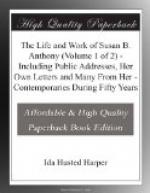Thus as I passed from town to town was I made to feel the great evil of woman’s utter dependence on man for the necessary means to aid reform movements. I never before took in so fully the grand idea of pecuniary independence. Woman must have a purse of her own, and how can this be so long as the law denies to the wife all right to both the individual and the joint earnings? Reflections like these convince me that there is no true freedom for woman without the possession of equal property rights, and that these can be obtained only through legislation. If this is so, then the sooner the demand is made, the sooner it will be granted. It must be done by petition, and this, too, of the very next legislature. How can the work be started? We must hold a convention and adopt some plan of united action.
With her, to think was always to act. She reached Rochester on the morning of election day, and went at once to the home of William and Mary Hallowell, that home whose doors never were closed to her, where for more than fifty years she was welcome day or night, where she always turned for advice, assistance and sympathy and ever found them in the fullest measure. She explained to them her idea of calling a meeting in Rochester for the specific purpose of starting a petition for more extended property rights to women. They encouraged the project, and she then turned toward her other Mecca, the home of Maria G. Porter. Three of the Porter sisters kept a private school in this city for thirty years, while the eldest, Maria, made a home for them and also took a select class of boarders. This was a literary center, she often invited Miss Anthony to meet her distinguished guests, and ever encouraged and sustained her public work. Mr. Channing was boarding here, and when Miss Anthony unfolded her plan, he exclaimed, “Capital! Capital!” and at once prepared an eloquent call for the convention. This meant for her the writing of letters to scores of influential people asking their signatures, which were almost invariably given, and was followed by all the drudgery necessary for every meeting of this kind.
[Autograph:
W. H. Channing]
The convention opened Nov. 30 at Corinthian Hall, Rev. May presiding and Rev. Channing the leading spirit. Two forms of the petition were adopted, one for the just and equal rights of women in regard to wages and children; the other for the right of suffrage. Miss Anthony was appointed one of the lecturers, and also put in charge of the petitions. Sixty women began circulating these, and she herself canvassed her own city, lectured in a number of towns, and at the same time made arrangements for a State suffrage convention to be held in Albany February 14 and 15. At this time Parker Pillsbury wrote to Lydia Mott:




